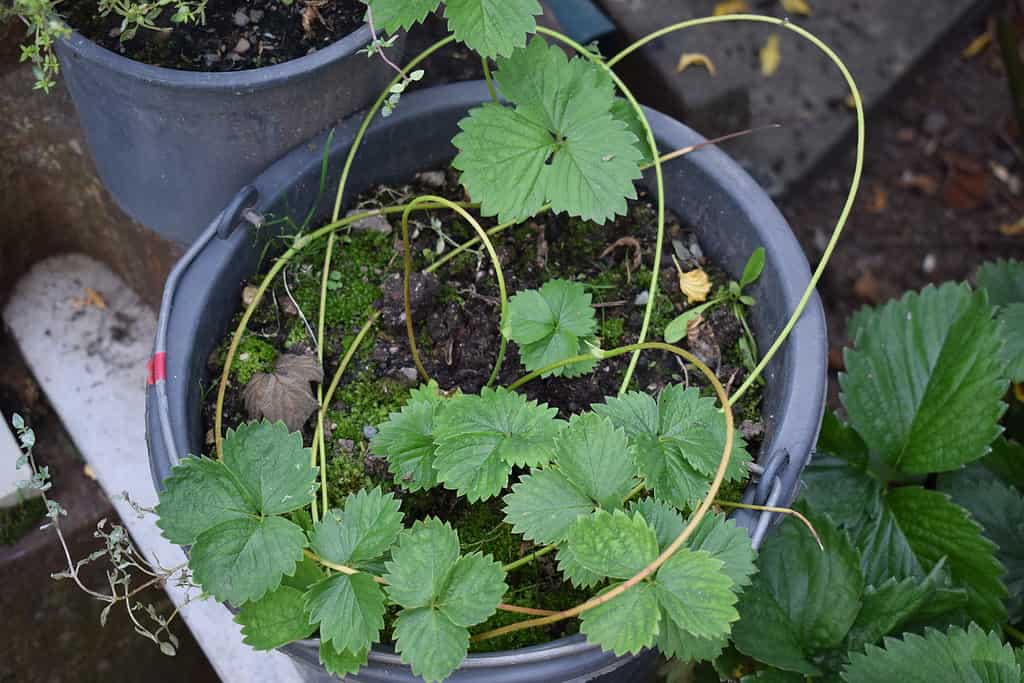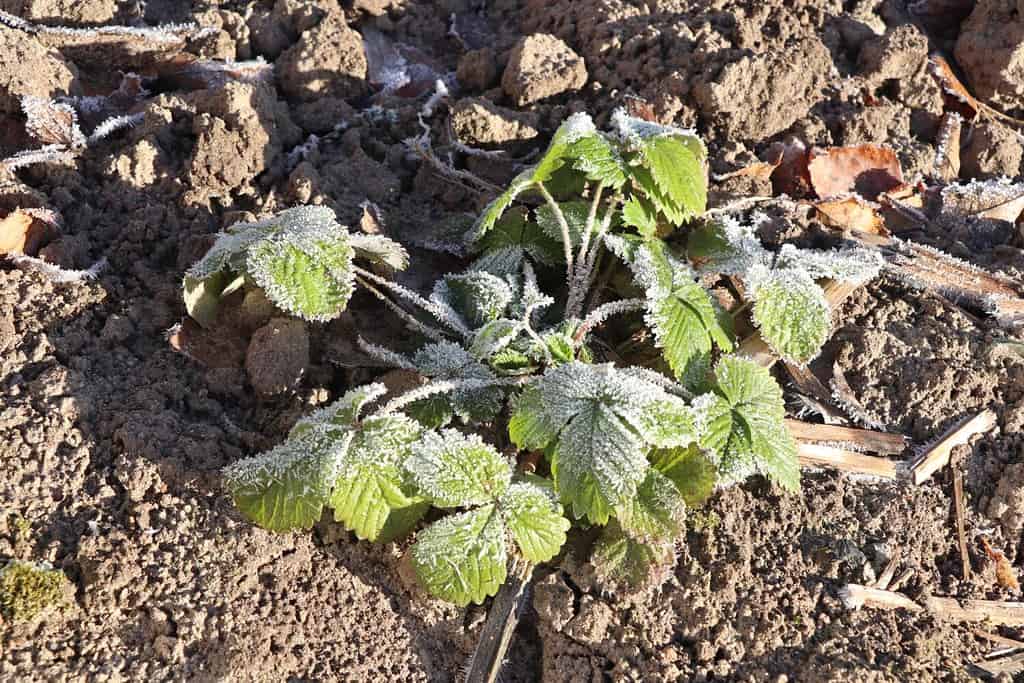Strawberries are one of the easiest and most delicious fruits to grow in pots for a delicious, nutritious summer snack. Then comes the long wait over the winter to taste them again. This leads many aspiring gardeners to wonder: can strawberry plants survive winter in pots?
In this article, we’ll cover whether strawberries can survive, steps to improve your yield, and tips for helping them thrive.
Let’s dig in!
Can Strawberries Survive Winter in Pots?

Strawberries are easy to grow in pots.
©Zlatimir Stojanovic/iStock via Getty Images
Strawberries can survive winter in pots in certain USDA zones or when transitioned indoors and cared for properly. In most cases, they’ll go dormant during the winter and produce new berries in the spring.
It’s important to note that even with proper indoor care, strawberry plants will only have a few successful years as perennials. Cultivating new plants is better for ongoing growth and full crops.
How to Overwinter Strawberries

Store strawberry pots in a cool, temperature-consistent space.
©Markus Volk/iStock via Getty Images
There are a few considerations to keep in mind when keeping strawberries over the winter: whether you want an extended growing season and your climate, to name a few. Here are some top considerations for overwintering strawberries.
Choose the Right Strawberries
There are many species of strawberries to choose from when growing your own crop. When choosing strawberry plants to overwinter, look for either an ever-bearing strawberry or a June-bearing strawberry.
Ever-bearing strawberries produce two to three harvests in a growing season. This is your best option if you’re looking for more strawberries during the fringe season. However, these plants also go dormant during the winter.
June-bearing strawberries produce crops early in the harvest season and can produce fruit for up to five years with proper care.
Prune and Prepare
After your final harvest, watch your plants for signs of dormancy. The leaves will become brown and shriveled. At this point, you can trim away the dead tissue. Avoid trimming before the leaves are completely brown to allow your plant to redirect nutrients to the stem and roots.
Temperature Requirements
Temperature consistency and cold air are essential for dormant strawberry plants. An unfinished basement or unheated garage typically offers a balance of both.
If the temperature fluctuates too much, it will stimulate growth and then trigger dormancy again throughout the winter season. This fluctuation uses a lot of the plant’s stored energy and will diminish next year’s yield. Similarly, cold air is necessary to keep the strawberries dormant.
Adding a layer of insulation around the pots will also help maintain warmth and consistent temperatures in USDA zones that drop below freezing for extended periods.
Pest Protection
Hungry rodents may try to eat your strawberry plants during the winter, especially if they’re in a shed or garage. Covering the plant with a thermal blanket will help reduce pest invasions.
If you know rodents are an issue in the winter, set some traps or use a natural odor-based deterrent to keep them away. Moth or cotton balls soaked in peppermint oil or cayenne will help keep pests at bay.
Light Requirements
Dormant strawberries do not require sunlight. Keeping them out of the sun and heat will help them stay dormant and improve their yield next spring. Think of this phase as a hibernation for your plants!
Watering Requirements
Keeping the soil moist during dormancy is important for helping strawberry plants survive winter. However, there’s a balance between maintaining moisture and drowning your plants, which is crucial for their survival.
Give your strawberry plants a thorough watering when you transition them into their winter location. Check the soil every 7-10 days and offer water as needed. Using a couple of ice cubes or a handful of snow from outdoors will help maintain soil moisture, as it will melt slowly in the cool environment.
Frost Protection
If temperatures in your garage or storage shed dip below 30°F (-1°C), consider covering the tops of your strawberry plants for extra protection. If you’re already using a thermal blanket to deter pests or improve temperature consistency, you’re all set!
Transition Your Strawberries Indoors
This step is important if you’re transplanting planted strawberry plants to pots for the winter—a smart move for people in extremely cold winter environments.
Water your strawberry plants thoroughly a few days before transplanting them into pots. Once they’re in the pots, leave them outdoors for a few days to reduce shock. Then, move them indoors to their new location. The slower transition will help reduce shock that could harm your plants as they enter dormancy.
Prepare Your Plants for Spring
Once the risk of frost has passed, move your potted strawberries to a sunny location and increase the watering frequency. Feed them with some nutrient-rich compost or fertilizer to help stimulate growth. Be sure to look for signs of pests or infected tissue to remove before the growing season starts.
Alternatives to Overwintering Strawberries

Strawberries need protection from frost to thrive.
©willow_girl/Shutterstock.com
If overwintering strawberries isn’t right for you, consider these alternative options.
Seed Harvesting Strawberries
Harvest seeds from your strawberry yield to grow new plants in the spring. This option is ideal if you don’t have a place to store potted strawberries over the winter.
Propagating Strawberry Plants
Propagate your strawberry plants during the growing season to produce new plants. This option works well if you want to try greenhouse or indoor growing during the winter months. Staggering your propagation strategy could earn you a continuous yield of strawberries throughout the winter. It won’t be easy, but it will be worth it!
The photo featured at the top of this post is © nikoniko_happy/iStock via Getty Images
Thank you for reading! Have some feedback for us? Contact the AZ Animals editorial team.






